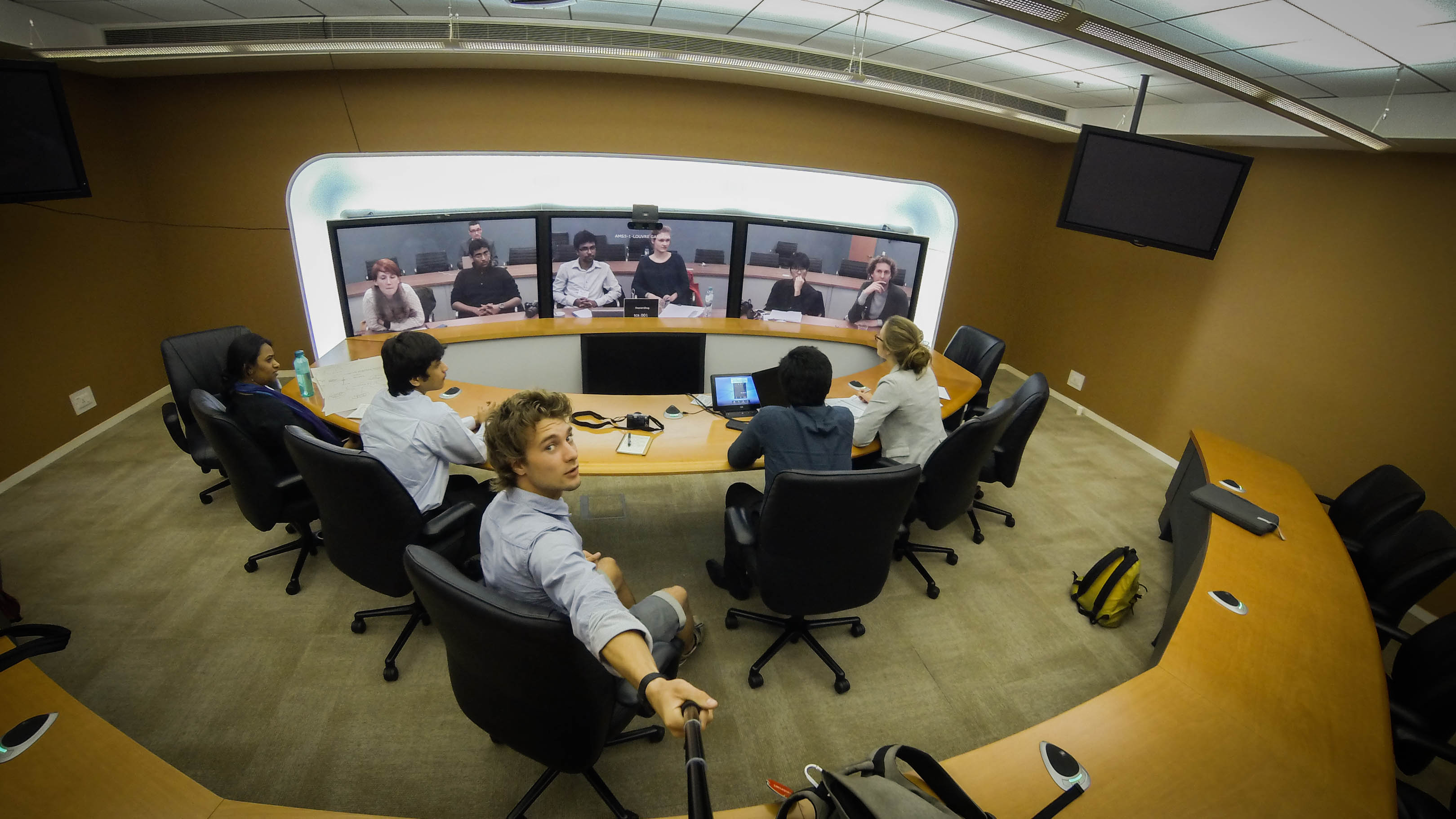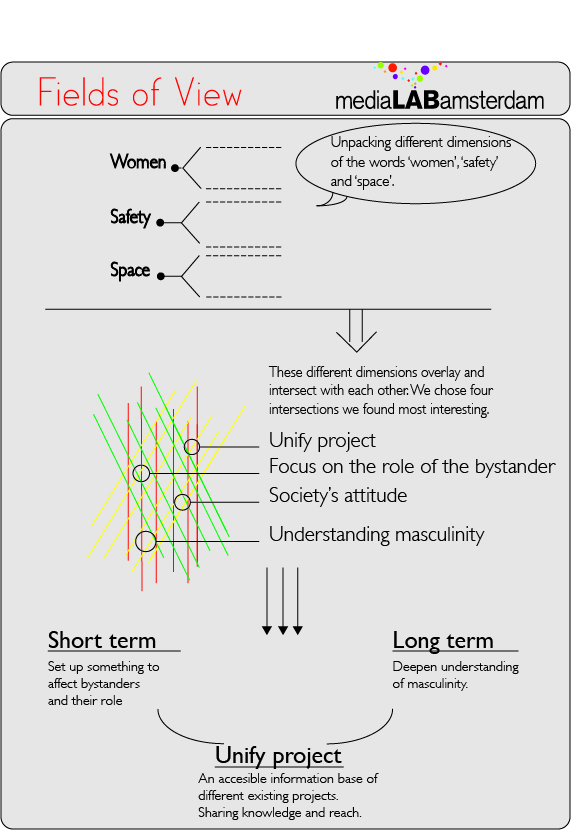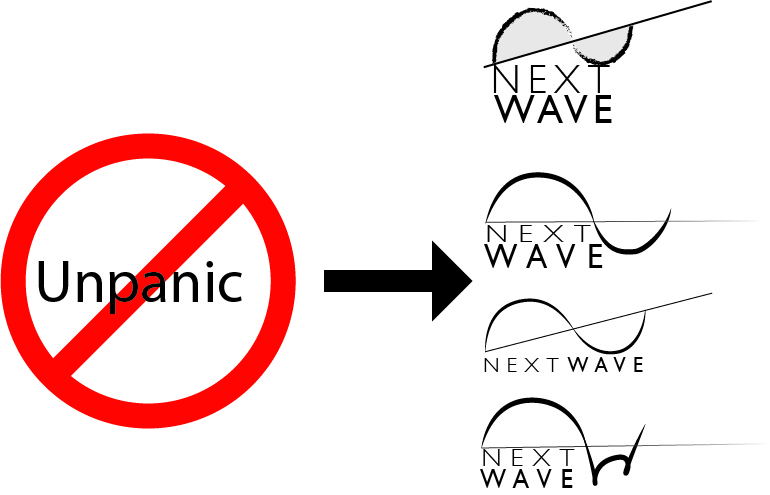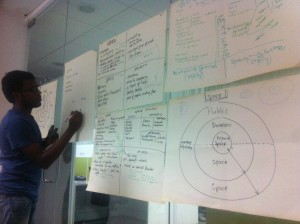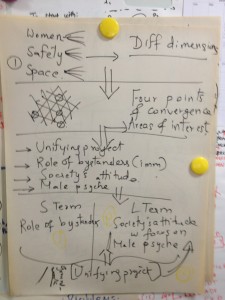MediaLAB and Fields of View, telepresence at Cisco
Suit up! On the 17th of October we went for a little trip to the city… the day of the telepresence call with the MediaLAB Amsterdam.
As we might have told you already, the project we are working on is a mirrored project, meaning our team started out with the same research question/topic as the team in the MediaLAB Amsterdam: Women’s Safety in Public Space. Our main funder, Cisco, facilitates high-end, high-tech, monthly meetings to showcase our findings in this cross-cultural project. Our weekly Skype meetings are nothing compared to this state-of-the-art, almost immersive experience, diminishing distance as the office in Amsterdam and Bangalore are real-time connected . Look at this!
This meeting was, for us, the first formal meeting for this project. We looked forward to it. We prepared a little presentation summing up what findings we had so far. In this blog post we will recap what we told in that presentation at Cisco. Although our project at this moment has taken some steps further, we didn’t want you to miss this. These are descriptions of the path we followed, people we spoke to, decisions we made, things we’ve learned and our future plans (approximately one month ago). Because we made a very simplistic presentation in Prezi, which you can find here, I will add a little more flesh to this skeletal structure. I will give you four key decision points.
When we got introduced to this project roughly 4 months ago, it was called the ‘Panic Button’ project. The idea originated in one of the classes a professor here gave. The conversation was about a device, that would be unobtrusive, easily wearable and maybe even fashionable. The idea of a device to use in case of panic was born.
When we arrived in the end of August, we had a lot of talks about what this project was actually all about. For starters we looked at the name, ‘Panic Button’, which was chosen as a temporary name. The main problem for us with this name was that it placed a strong accent on ‘panic’; something we wished to dismiss or avoid. Hence, a name that would imply the avoidance or removal of panic in a hazardous situation seemed better. “What about ‘Unpanic’? –Yes, sounds alright, let us take that for now.”
It was soon after this when our colleague, sociologist and gender expert Dr. Niveditha Menon sent us an interesting mail. She pointed out that with using the name ‘Unpanic’, we actually tell the users, in this and most other cases women, that they should ‘unpanic’. They should not be in panic, what ever happens to them. Or worse, they should not be overacting.
[…] if we are telling women NOT to panic we are telling them two things – One, that they do panic (which they do not), and that thy ought not to panic (why not? the fear is real enough). […] we are not in any position to tell woman NOT to panic, because frankly, do we have any right to? – Niveditha Menon
Here we were, working on a project with no name. We had to have something… so we started from scratch, again. What do we want to accomplish? What do we want to improve, help or solve? Is our problem even solvable? And if so, is there any change that would happen within our time here, a limited semester. We began blowing up our initial research question and deconstructed it.
The next topic of discussion regarding our project was whether or not we would be making a device. The initial plan, the panic button, would’ve been a device to be used in cases of panic, violence and/or harassment. We would not be touching the core or the cause of the problem by making such a device. In Dutch we have this beautiful saying: ‘It is like mopping the floor while the tap is still running’. The problem is rooted deeper and by making a reactive device we would not address the core problem. Another saying seems appropriate: prevention is better than cure. Though, preventing harassment would require an attitudinal or behavioural change, and how were we going to achieve such a complex task. We felt that we needed to split the project in different parts.
After thinking about what we wanted and needed, we started to draw it out. In the blog post “Recipe for curry” we wrote about how we then structured and prioritized our further research. You can read it again here if you like.
As we floated ideas freely, we concluded that we were not going to find a solution. We cannot solve this problem or make it disappear. This is not being pessimistic, solely realistic. Though, it’s not a reason to be disappointed or demotivated. We found that, even if we were not working towards a future without violence or sexual harassment, we could still be doing a meaningful project. We thought about it in a ‘two steps forward- one step back’ way. It is not that women don’t have rights here, because they do. They work, they vote, they do pretty much everything men do. Still, women are being restricted because they are not considered equal to men. It feels like new canals have been dug, but some boats still take the old route. It always takes time for changes to be accepted. In addition, every change brings about new sets of obstacles in its wake. It is like a wave movement, cyclical. Inspired by the feminist waves of women’s emancipation, we saw our project as contributing towards the crest of the next wave. Knowing we won’t make much change, if even any, our vision is to work on that next wave. The project would from now on be referred to as the ‘Next Wave’ project.
With our three approaches we went to see professionals and experts in the field. We asked them for feedback, tips&tricks and experiences. We are blessed with the availability of people who have been working in the field of gender, human- and women’s rights and activist-groups for years. How nice it was, therefore, to see that their way of thinking about this subject echoed our views. They liked the path we had walked thus far, but there was still a lot to do. After extensive discussions and almost personal lectures we mapped out the different aspects of this social crisis and how they were interconnected. Here is the map.
Now it was time to unite the knowledge we gained so far and start thinking about the research questions in each of the three approaches. The research questions would determine the choices we made. Here they are.
Keywords:
From safety to freedom, mobility, visibility and self-hood
Short term:
How can we facilitate informal reporting of sexual harassment in a physical space while ensuring institutional linkages?
Long term:
How can we design a tool for Indian men to interpret themselves, in a non-threatening way, so the frame shifts from entitlement to consciousness of power structures?
Unifying:
How can we design an online platform for organizations and a general audience, on organizations working to promote freedom of women?
The span of our plans is huge. We know that. We are not sure how far we will go, but we found it too difficult to narrow down our scope. For now, we are focusing on the short-term project, since this is the most feasible to accomplish within our stay.
Keep you posted!







